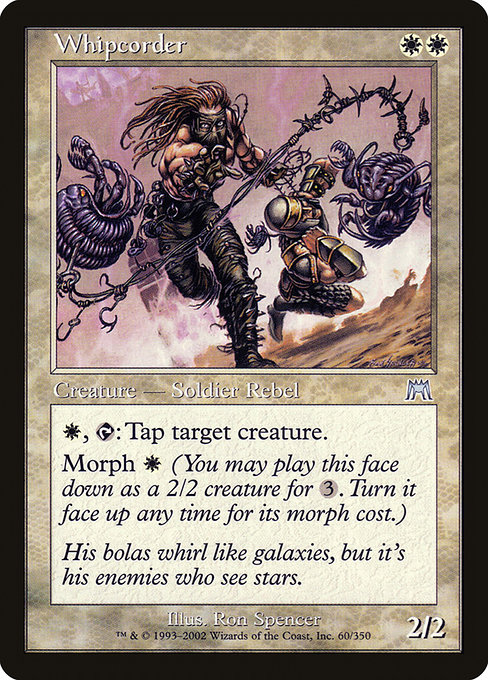
Image courtesy of Scryfall.com
Whipcorder: Tracing a White Rebel's Whip and the Hidden Language of Morph
In the white-hot frontier of Onslaught’s world, the name Whipcorder conjures a brisk, polearm-slinging image: a rebel who blends discipline with improvised toolwork, a soldier who punishes hesitation with a snap of cord and a calculated bite of mana. The card itself is a compact masterclass in how Magic narrates character through ability design. A two-mana, white creature with a crisp two-power, two-toughness frame—a sturdy 2/2—Whipcorder arrives not merely to attack or block, but to disrupt. Its ability, a tap-based removal, costs only a single white mana: “{W}, {T}: Tap target creature.” It’s simple, elegant, and very white—polish, tempo, and restraint rolled into a single package 🧙♂️🔥.
“His bolas whirl like galaxies, but it's his enemies who see stars.”
The flavor text is a hint of the card’s romantic, frontier-warrior vibe. It invites players to imagine a world where rebels improvise with rope, where a disciplined fighter uses a tether as both weapon and shield, and where the act of ordering a target to stop moving becomes a compact battlefield strategy. That evocative line also points toward the broader theme of morph in Onslaught: the ability to flip a face-down creature into a real, dangerous presence just when your opponent least expects it. The name Whipcorder itself fuses two ideas—whip and order—into a single, memorable identity that feels both ancient and immediate. It’s a nod to the era’s fascination with clandestine tactics and the quiet, brink-of-battle psychology that white often channels 🧭🎨.
Design, Morph, and the Whisper of White Removal
Whipcorder’s mana cost of {W}{W} makes it an early-game accelerant for white’s classic tempo archetypes. The mana cost pairs cleanly with white’s access to targeted disruption, letting you tap an opposing threat the moment it steps forward. But the card’s true sociability lies in its morph ability. Morph—costing {W} in this card’s case—lets you cast Whipcorder face down as a 2/2 for 3 mana, then flip it up later for its morph cost. This creates a powerful mind-game dynamic: your opponent sees only a nondescript 2/2 on the battlefield, while you hold a potentially game-altering removal trick in your hand, tucked behind a disguise, ready to reveal a real attacker or a crucial blocker at the perfect moment ⚔️. The Onslaught-era design language lends itself to this kind of layered interaction. Rebels, Humans, and Soldiers populate the war-scarred halls of the narrative, and Whipcorder stands at the crossroads of martial discipline and flexible execution. The ability to tap a creature the moment it becomes threatening embodies white’s tempo toolkit: you slow the opponent, buy time, and set up favorable exchanges. The rarity—uncommon—reflects the card’s dual nature: not a bomb of the set, but a dependable piece that rewards precise timing and reading of the battlefield. It’s the kind of card that makes you grin when you pull it from a pack and your opponent realizes you’ve been quietly building toward a well-timed tempo swing 💎.
Playstyle Notes: How to wield a Whipcorder in your deck
- Tempo and timing: Use Whipcorder to stall a key attacker while you set up a longer-term plan. The tap ability can stop a big threat on your opponent’s combat step, letting your board stabilize just long enough to land a reclaiming blow.
- Morph misdirection: Casting Whipcorder face down invites your opponent to overcommit. Then flip it up for a surprise removal or a critical blocker—this keeps you several steps ahead in the tempo race 🔥.
- White synergy: In the broader white shell, Whipcorder benefits from a library of efficient removal and creature control. Its presence is a reminder that sometimes the simplest tools—the tap of a target creature—can create the most durable advantages ⚔️.
- Format considerations: Legacy and Vintage hosts the deepest bench for white control and tempo strategies, with Whipcorder fitting as a compact, surprising piece in the Rebel/Soldier flavor. It’s also legal in Commander, offering retro-chic nostalgia for themed decks that celebrate iconic white restraint 🧙♂️.
Collectors will note that Whipcorder came into the world as part of Onslaught’s dark, artifact-scarred landscape. The card’s art—by Ron Spencer—captures an austere, gritty warrior whose resolve is as much about the whip’s crack as the moment of realization when an opponent recognizes their plan was foiled by a measured tap. The card’s high-resolution scan and borderless black frame are a visual reminder of an era that loved both the flavor of rebellion and the elegance of a well-timed removal. If you’re chasing a tactile link to early-2000s nostalgia, the foil version of Whipcorder carries a distinct shine that makes the 2/2 body and morph texture practically sing on the table 💎✨.
From a narrative perspective, the name Whipcorder invites players to imagine the card as a character in a frontier fable: a determined rebel who coordinates with others to disrupt a regimented foe, a commander who knows when to snap a whip and when to snap a spine—the enemy’s, not his own. This duality is what makes the card linger in memory, a small but potent emblem of a world where every choice on the battlefield feels like a story in motion 🧙♂️.
Foot-shaped Memory Foam Mouse Pad with Wrist RestImage courtesy of Scryfall.com
More from our network
- https://crypto-acolytes.xyz/blog/post/what-minecraft-updates-could-come-next/
- https://transparent-paper.shop/blog/post/demystifying-social-media-algorithms-what-drives-your-feed/
- https://transparent-paper.shop/blog/post/youtube-shorts-vs-tiktok-ads-which-drives-more-conversions/
- https://crypto-acolytes.xyz/blog/post/steve-coogan-explains-alan-partridge-visiting-not-living-together/
- https://transparent-paper.shop/blog/post/designing-wedding-planner-printables-a-creative-guide/